KRAMDEN VS. FLINTSTONE
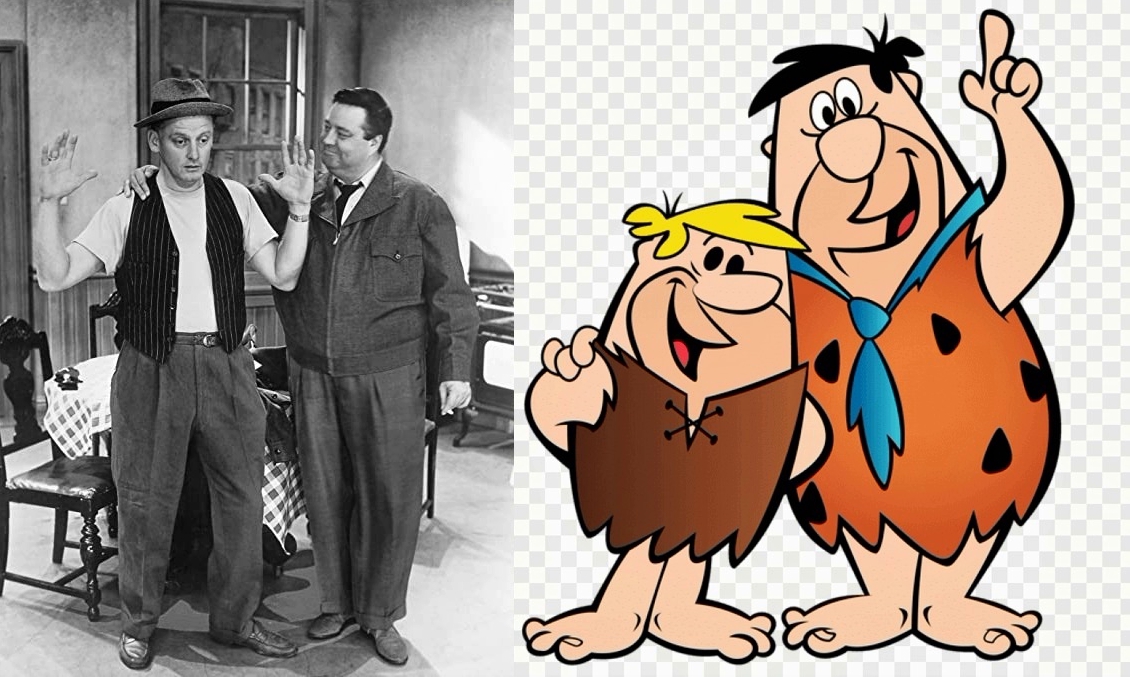 The popular 1960s cartoon The Flintstones became a hit around the world but was not well received by one of television’s most iconic actors of all time, Jackie Gleason. According to Alan Reed Jr. (son of Alan Reed, who voiced Fred Flintstone), The Flintstones was inspired by The Honeymooners, Fred taking on the short-tempered and overbearing characteristics of Gleason’s vociferous Ralph Kramden while Barney’s rather goofy nature was modeled on Art Carney’s Ed Norton.
The popular 1960s cartoon The Flintstones became a hit around the world but was not well received by one of television’s most iconic actors of all time, Jackie Gleason. According to Alan Reed Jr. (son of Alan Reed, who voiced Fred Flintstone), The Flintstones was inspired by The Honeymooners, Fred taking on the short-tempered and overbearing characteristics of Gleason’s vociferous Ralph Kramden while Barney’s rather goofy nature was modeled on Art Carney’s Ed Norton.
Gleason was none too pleased that the modern stone-age family was patterned after his beloved show and contemplated suing the creators of the cartoon. Although Gleason’s lawyers informed the actor that he could have The Flintstones canceled, they cautioned him that he would be known as “the guy who yanked Fred Flintstone off the air.” Understanding that many children and parents would be saddened, Gleason ultimately decided to let bygones be bygones.
True Golden Oldies
Heard any good music lately?
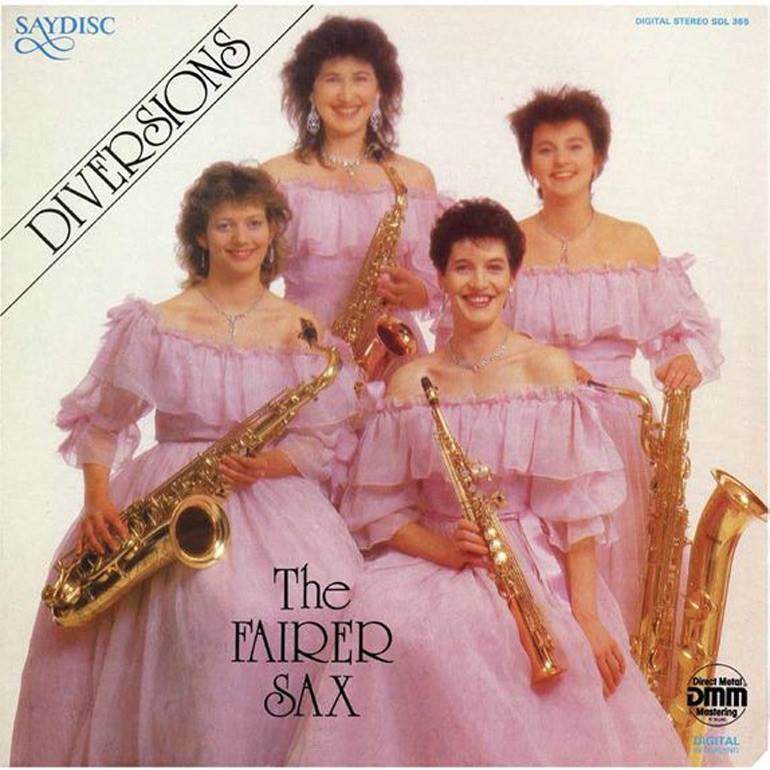
Prediabetic? Here’s What You Can Do!
As we move through our 50s and 60s, many of us are informed by our doctors tht we are prediabetic – meaning we run the risk of developing diabetes in the near future.
is there anything we can do to prevent that?
Actually, there is. Medical experts stress two things:
1.) Lose weight – If you’re overweight, bringing your weight back within normal guidelines reduces the chances of you becoming diabetic.
2.) Exercise – This really helps reduce your risk.
So don’t take that diagnosis lying down. Get active and get healthy!
Lucy in the Sky with Diamonds - The Story Behind the Song
A good many people just assume that one of the Beatles’ best-known songs from the Sgt. Pepper era, “Lucy in the Sky with Diamonds” is about drugs. I mean, the initials spell out L-S-D, amirite?
Not so fast. John Lennon has always claimed the inspiration for the song’s title came from a picture his young son, Julian, drew. Julian said the picture was of his young schoolmate, Lucy O'Donnell, and that he did, in fact, tell his dad that it was a picture of Lucy in the sky with diamonds.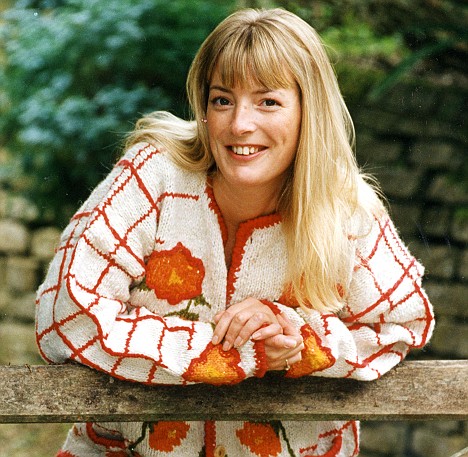 That the song contained such trippy lyrics should surprise no one. Lots of pop songs of the period also contained such lyrics; and Lennon always said his inspiration for the song’s imagery came from Lewis Carroll’s Through the Looking Glass, a favorite of flower children everywhere.
That the song contained such trippy lyrics should surprise no one. Lots of pop songs of the period also contained such lyrics; and Lennon always said his inspiration for the song’s imagery came from Lewis Carroll’s Through the Looking Glass, a favorite of flower children everywhere.
Julian Lennon’s drawing still exists. It now belongs to Pink Floyd member, David Gilmour. Alas, there was no happy ending for Lucy. She married and became Lucy Vodden, but passed away from complications arising out of lupus at the very young age of 46 in 2009.
TV That Time Forgot: I’m Dickens, He’s Fenster (1962)
A wild sitcom that lasted only a single season, but should have lasted longer, I’m Dickens, He’s Fenster had a talented cast. John Astin was Harry Dickens, while Marty Ingels played Arch Fenster, two borderline incompetent carpenters. Emmaline Henry appeared as Dickens’ wife, Kate.
Other series regulars were the construction crew that joined the title character on jobs: Frank DeVol as Myron Bannister, David Ketchum as Mel Warshaw, Henry Beckman as Bob Mulligan, and Noam Pitlik as Bentley. Notable guest stars who appeared during the show’s brief run included Harvey Korman, Ellen Burstyn, Lee Meriwether, and Yvonne Craig.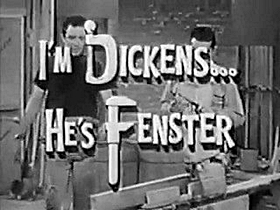 The show debuted in September of 1962 on ABC in what should have been a very cushy spot between The Flintstones and 77 Sunset Strip. The show was also filmed before a live audience, which was unusual at that time for a show that didn’t feature a well-known star (like Lucille Ball). Alas, the show ran opposite Sing Along with Mitch on NBC and Route 66 on CBS and never attracted enough of an audience for the network to greenlight a second season.
The show debuted in September of 1962 on ABC in what should have been a very cushy spot between The Flintstones and 77 Sunset Strip. The show was also filmed before a live audience, which was unusual at that time for a show that didn’t feature a well-known star (like Lucille Ball). Alas, the show ran opposite Sing Along with Mitch on NBC and Route 66 on CBS and never attracted enough of an audience for the network to greenlight a second season.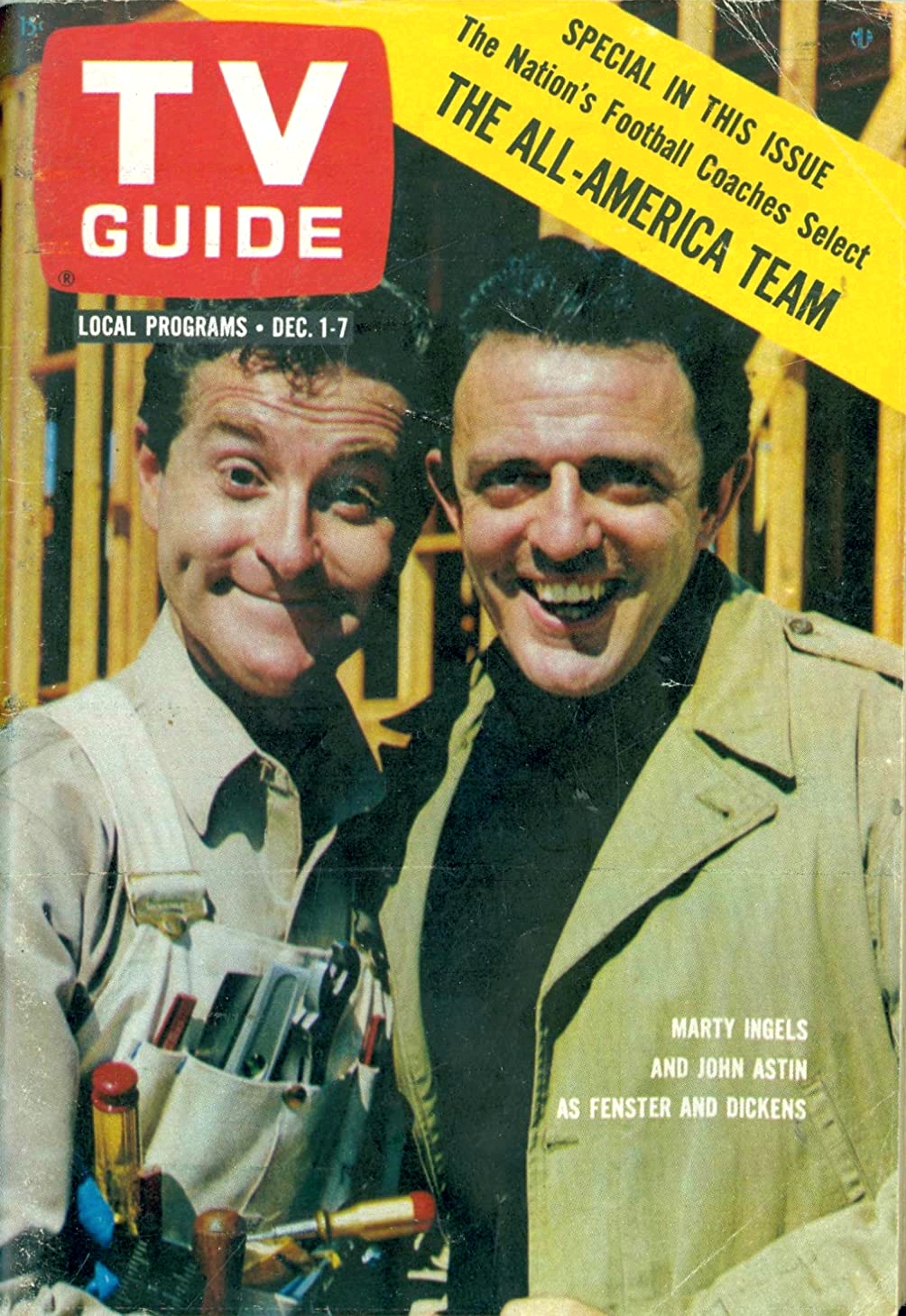 All the principals went on to greater glory. Astin, of course, became famous as Gomez Addams, Ingels had a lucrative career doing voices for Saturday morning cartoon series (and marrying Shirley Jones), and Emmaline Henry was regularly seen on I Dream of Jeannie as the wife of Dr. Bellows. She was also slated to become a regular on Three’s Company when she passed away at the young age of 50.
All the principals went on to greater glory. Astin, of course, became famous as Gomez Addams, Ingels had a lucrative career doing voices for Saturday morning cartoon series (and marrying Shirley Jones), and Emmaline Henry was regularly seen on I Dream of Jeannie as the wife of Dr. Bellows. She was also slated to become a regular on Three’s Company when she passed away at the young age of 50.
Despite it lasting only one season, a DVD set of 16 of the show’s 32 episodes is available.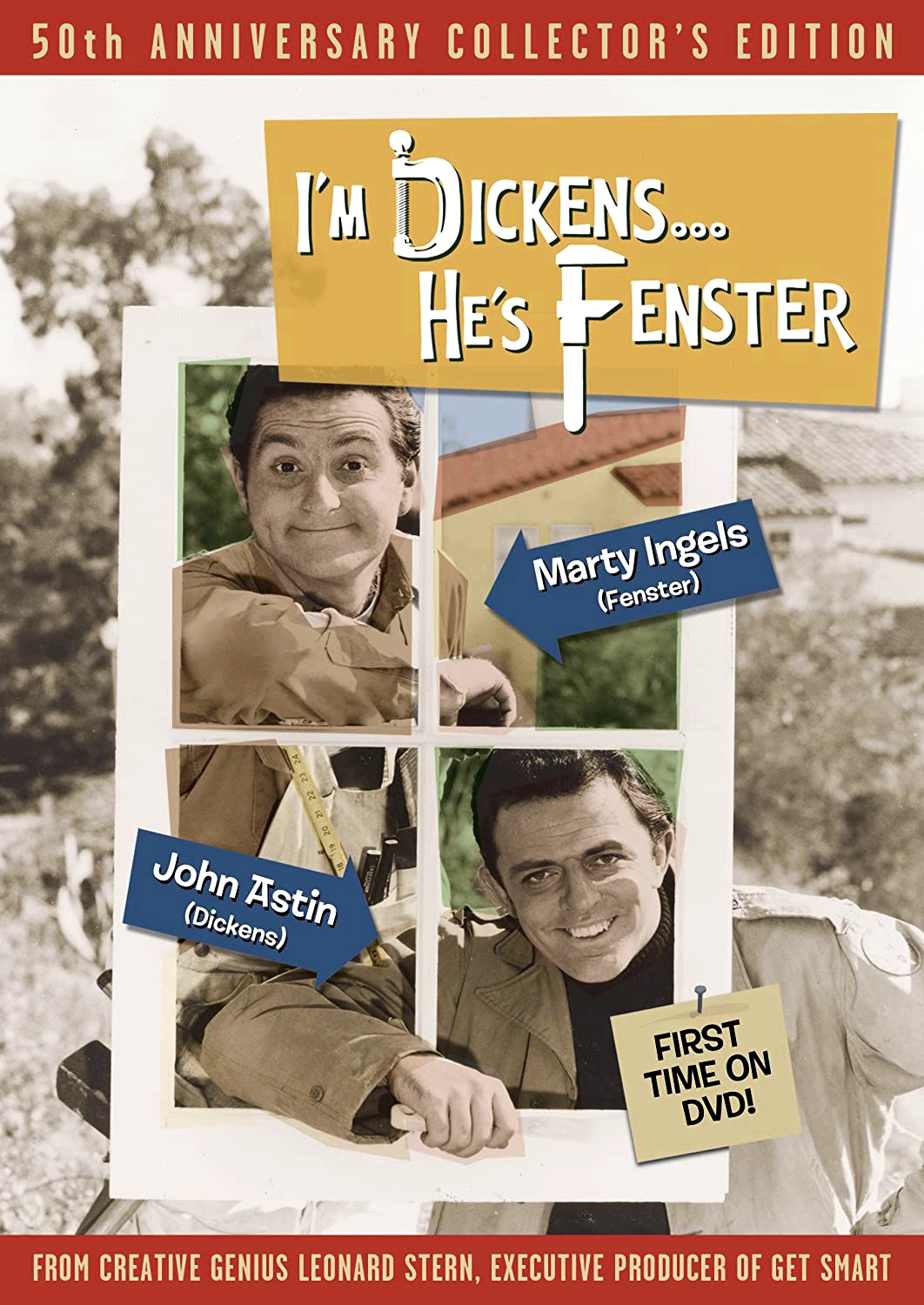
Great Moments in 1950s Advertising
More from the Files of 16 Magazine
From the Files of 16 Magazine
Among those oldies but goodies, this heartfelt plea from a fan to Frankie Avalon from 16 Magazine, September, 1960!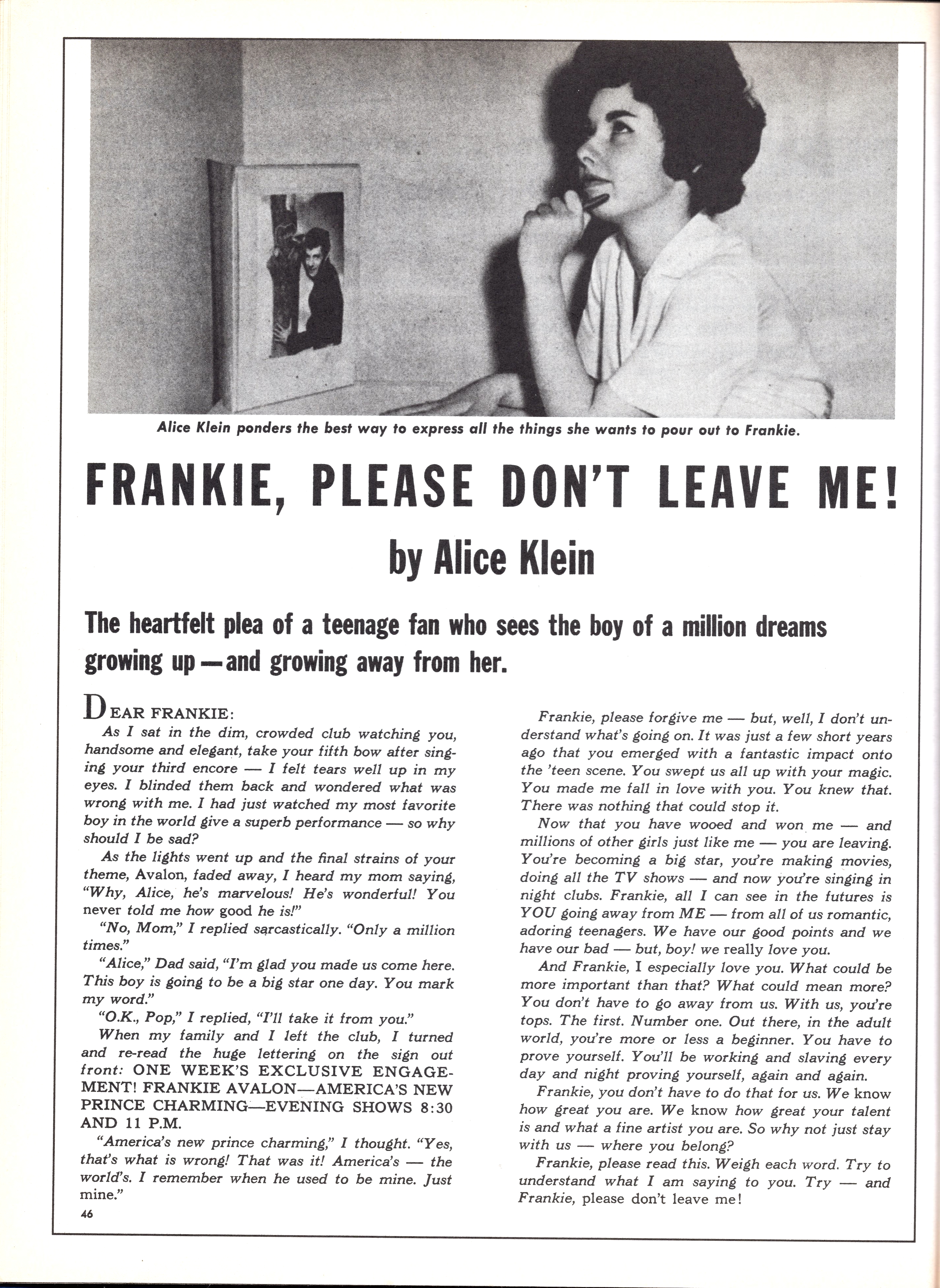
Frankie’s response follows below.
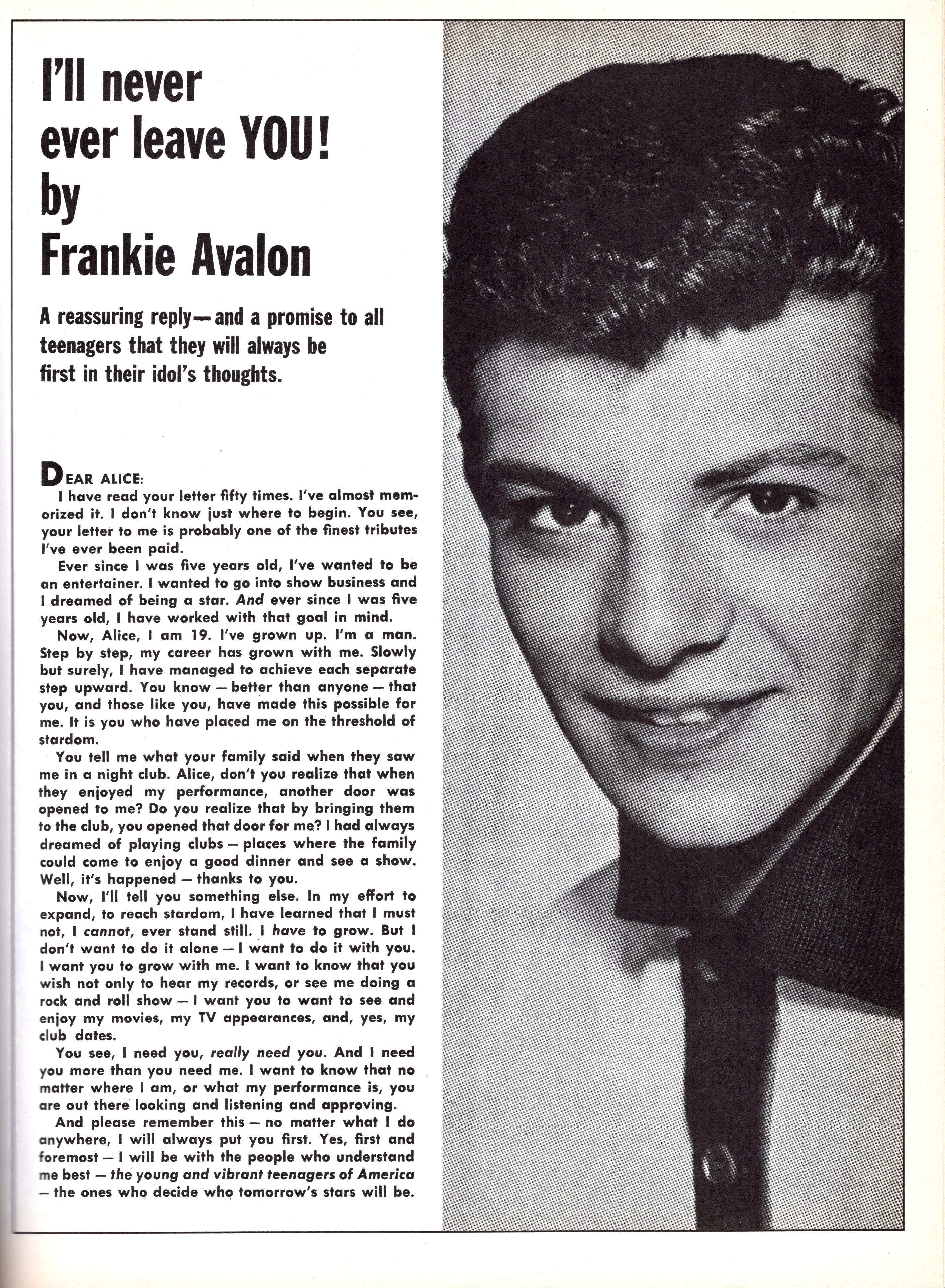
Rebel Without a Cause (1955)
 Is there a Baby Boomer worthy of the name that hasn’t seen Rebel Without a Cause? Doubtful, James Dean in that red jacket has become an everlasting icon of teenage angst and ambivalence.
Is there a Baby Boomer worthy of the name that hasn’t seen Rebel Without a Cause? Doubtful, James Dean in that red jacket has become an everlasting icon of teenage angst and ambivalence.
But here are a few things about that classic film you may not know:
The title comes from a 1944 book – Warner Brothers purchased the rights to a book about a juvenile delinquent named Harold who wound up in the federal pen in Pennsylvania, For years, they tried to work into an acceptable screenplay. In fact, one of the first writers to try was a guy named Theodore Geisel – or as we know him better – Dr. Seuss.
None of the screenplays proved acceptable. Then, in 1954, director Nicholas Ray brought Warner Brothers his idea for a film about affluent juvenile delinquents called The Blind Run. Warners liked Ray’s ideas but wanted him to combine it with the book they’d already purchased. By the time the final script was completed, about the only thing left from that 1944 book was the title: Rebel Without a Cause.
Marlon Brando almost played the lead – Back when Warners was trying to adapt the original book, they thought they were close to being ready to start shooting. So, in 1949, they began the process of casting the film and approached Marlon Brando to play the lead. Ultimately, that version of the film fell through and Brando had to wait until 1953’s The Wild One before he’d be given his chance to play an iconic bad boy.
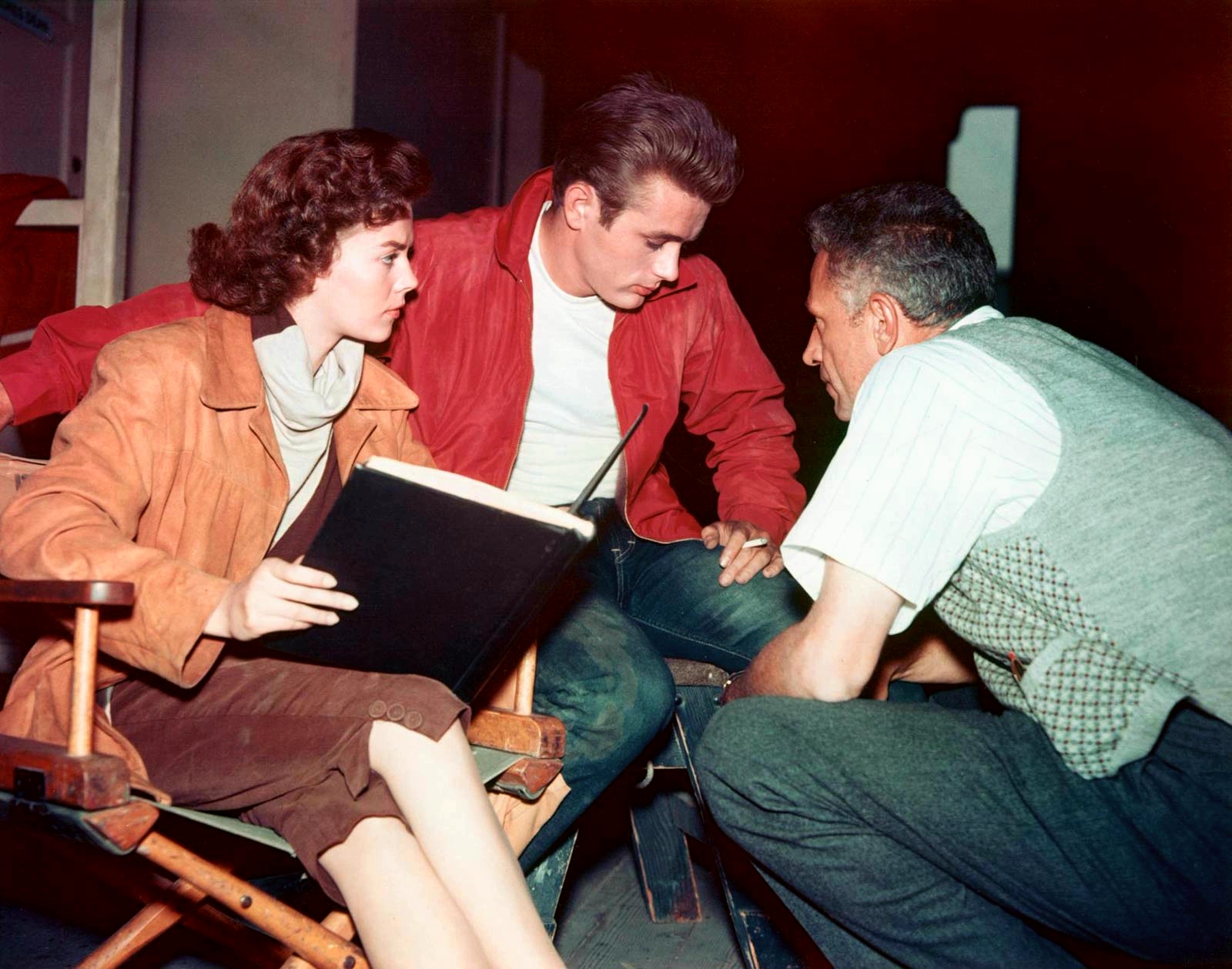 Natalie Wood was romantically involved with both Dennis Hopper & Nicholas Ray while the movie was filming – Natalie came into the film when she was dating Hopper. However, she soon began an affair with Nicholas Ray, the film’s director, as well. Hopper found out and challenged Ray to a fistfight. Ray declined the fight but retaliated by reducing Hopper’s role in the film to a non-speaking one.
Natalie Wood was romantically involved with both Dennis Hopper & Nicholas Ray while the movie was filming – Natalie came into the film when she was dating Hopper. However, she soon began an affair with Nicholas Ray, the film’s director, as well. Hopper found out and challenged Ray to a fistfight. Ray declined the fight but retaliated by reducing Hopper’s role in the film to a non-speaking one.
There was an actual gang member in the cast – The part of gang member Crunch was played by Frank Mazzola, who was a member of a real “social club” called the Athenians at Hollywood High School. Mazzola told director Ray that many of the elements of the script as well as costumes and cars were phony. He even took Dean and Ray to an actual gang meeting where members of the gang roughed up the director and star a bit. After that, Ray gave Mazzola an office at the studio and had him doing double duty as a consultant on all the gang-related aspects of the film. It was Mazzola who picked out Dean’s 1949 Mercury for the drag race scene.
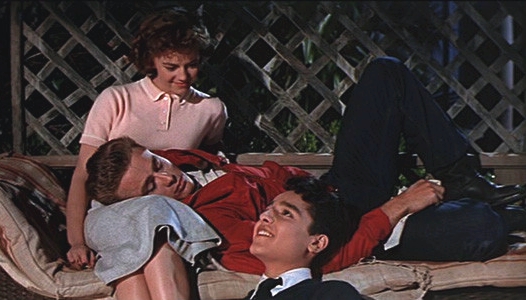 Is the script more Shakespeare or fairy tale? – Director Ray often told people he based his vision of the story on Shakespeare’s Romeo & Juliet. But the guy who did the final version of the script, Stewart Stern, said he was basing his version on James Barrie’s Peter Pan with Dean as Peter, Natalie as Wendy, and Sal Mineo standing in for all the Lost Boys.
Is the script more Shakespeare or fairy tale? – Director Ray often told people he based his vision of the story on Shakespeare’s Romeo & Juliet. But the guy who did the final version of the script, Stewart Stern, said he was basing his version on James Barrie’s Peter Pan with Dean as Peter, Natalie as Wendy, and Sal Mineo standing in for all the Lost Boys.
The film was supposed to be in black & white – Both the director and screenwriter thought the movie would work best in black and white, just as Blackboard Jungle and The Wild One had been shot. But Warners wanted the film to be shot in Cinemascope and there was a clause in Cinemascope’s contract with the studio that demanded all Cinemascope features be shot in color. So that was that.
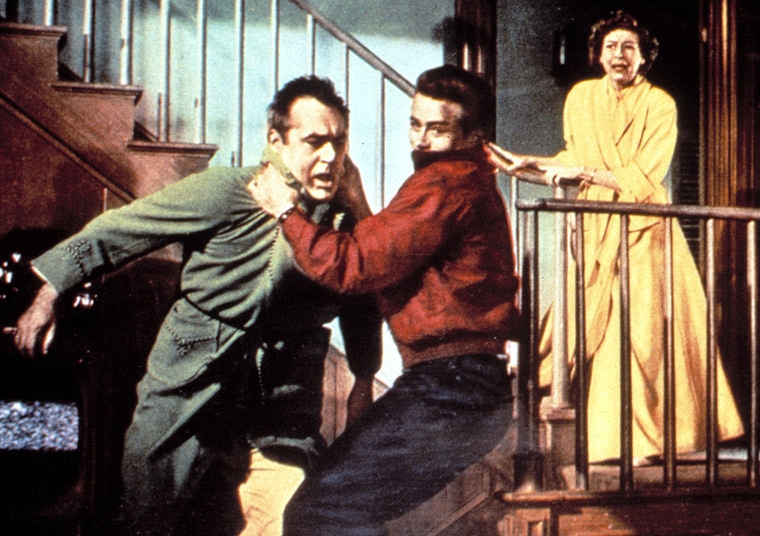 Nicholas Ray virtually handed over the director’s chair to James Dean – All of the principals involved in the shoot said that Ray pretty much let James Dean call his own shots on the scenes he appeared in. That included giving Dean plenty of room to improvise and to give instructions to the other actors appearing in scenes with him. Dean once flew into a rage when Ray yelled “Cut” during a scene, telling the director that Dean would be the one to decide when the cameras should cut.
Nicholas Ray virtually handed over the director’s chair to James Dean – All of the principals involved in the shoot said that Ray pretty much let James Dean call his own shots on the scenes he appeared in. That included giving Dean plenty of room to improvise and to give instructions to the other actors appearing in scenes with him. Dean once flew into a rage when Ray yelled “Cut” during a scene, telling the director that Dean would be the one to decide when the cameras should cut.
All 3 of the film’s stars met tragic, untimely deaths – Of course, the most famous one was Dean’s himself, who was killed when he lost control of his car just two weeks before the film opened. But Sal Mineo was also murdered outside his home at the age of 37 and Natalie Wood drowned in what are still mysterious circumstances at the age of 43.
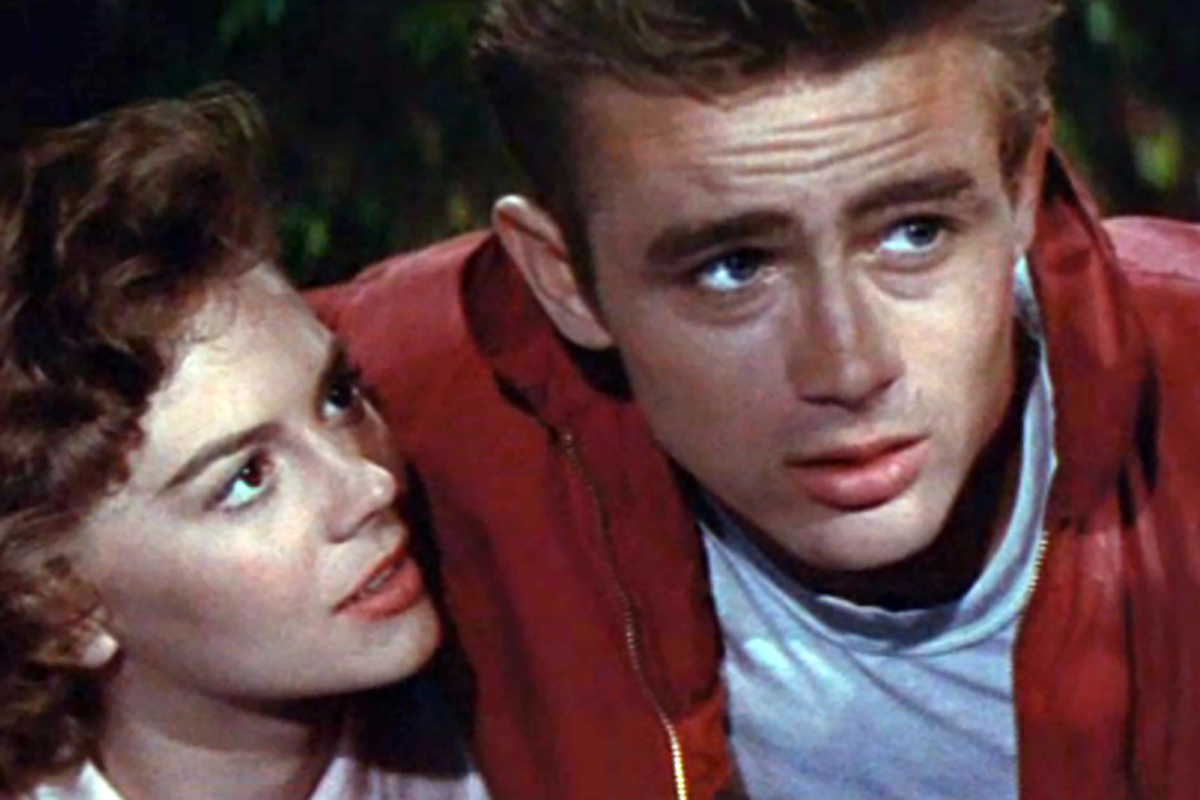
Max the Money from Your Garage Sale
Here’s a fast, easy tip for making more money the next time you decide to hold a garage or yard sale – get paid by phone!
You know those credit card readers you find at restaurants and retail outlets? You can get one that attaches to your phone and allows you to accept plastic!
Find out how simple it is to get one for FREE at squareup.com!
Pop Up Player
Latest Posts–Movies & TV
-
Alfred Hitchcock Presents
While often lumped together with “The Twilight Zone” and “Boris Karloff’s Thriller,” “Alfred Hitchcock Presents” is the true original, debuting 4 years before TZ and 5 before “Thriller.” Alfred Hitchcock’s show was also different than…
-
The TV That Time Forgot: The Donna Reed Show
For 8 seasons, The Donna Reed Show provided Baby Boomers with a sort of Mother Knows Best amid a ton of family sitcoms focused on the father. Cast as Donna Stone, Donna presided over a…
-
Friday Night at the Drive-In: Lover Come Back (1961)
Sequels & remakes? Nothing new here – Hollywood’s been recycling stuff ever since the first “magic lantern shows.” Want proof? Let’s settle in to watch one of those terribly puritanical “sex comedies” from the Sixties…
-
The TV That Time Forgot: The Millionaire
Boy! Could we use a show like this in real life! From 1955 to 1960, for 5 seasons an eccentric millionaire would give away $1 million to somebody he never even met. We were allowed…
-
Summer at the Triple-R
One of the biggest, most popular TV shows from the Baby Boomers' childhood was The Mickey Mouse Club. Airing after school Monday through Friday on ABC, it was “must-see TV” for our generation. While the…
-
The Bombshell and the Virgin
The two biggest box office attractions of the late 1950s and early 1960s had many similarities and two huge differences. Both were blondes. Both were very attractive. Both changed their names when they got into…








